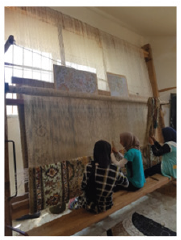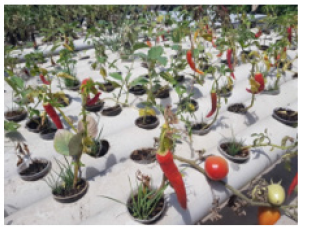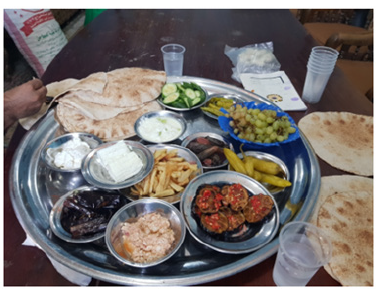- Submissions

Full Text
Trends in Textile Engineering & Fashion Technology
Art and Crafts are the Secret Answers against Poverty in Nagaa Oun
Samia Elsheikh*
Professor at Helwan University, Faculty of art education, Egypt
*Corresponding author:Samia Elsheikh, Professor at Helwan University, Faculty of art education, Egypt
Submission: December 06, 2022; Published: December 22, 2022

ISSN 2578-0271 Volume 7 Issue5
Opinion
Children growing up in poverty and disadvantage are less likely to do well at school. This feeds into a disadvantage in later life, and in turn, affects their children [1]. But what if the children don’t have a school, or the school is not equipped with the simplest teaching facilities? What if the most concern is food?
In the world’s pause time, many spots of the world were affected by the lack of food, money, and education. Children were off from schools spending their time playing, parents were off work, and there is no production of food and no money. (Nagea Oun) is a very poor community. The whole family works for a living. Their homes are made of tin shacks and leftover timber. The only school was old, cracked, and ill-equipped to accommodate children; this was a good reason for children to drop out of school to help their parents with the sustenance for living. The people of the village repeatedly complained about the poor conditions and the lack of services but there is no life for those who live in the village, so they found no alternative to following the old wisdom: “Light a candle instead of cursing the darkness.”
The people in the village achieved self-sufficiency in vegetables and providing bread for those who are deprived of the ration card , and establishing many craft projects. Before Covid19 hit the world, this village was part of a community development project carried out by a benevolent woman . She built a center for traditional crafts for girls and boys who dropped out of the school (Figure 1&2). Most of them are teenagers. In the time of the pandemic, there is no work and no food. The center started to make a surviving system, cultivating vegetables on the roofs of the houses (Figure 3), even chicken hatch cabinets for the villagers (Figure 4).
Figure 1: Girls working on a rug loom.

Figure 2:girls making crochet products.

Figure 3:A cultivated roof with vegetables.

Figure 4: Chick hatch cabinet.

In my first fortunate visit to Nagaa Oun, I found a group of villagers who were willing to learn anything to define their style and get more attention for the community. They were very kind that offered me their homemade food (Figure 5), vegetables that were made from Egyptian recipes; it was very tasty and made with love
Figure 5: A food tray to welcome the author on this visit.

“Most of the houses were without roofs (Figure 6), and the people were forced in the winter to raise the beds on stones so that the children could sleep under the beds, so water doesn’t reach them during the rain. Other problems with which no discussion of development is real, for providing human life is the basis for all this, which is what we have worked on for more than two years. We will not succeed until we are providing for every human being of the village” said: Shikh Ragab” .
Figure 6: Naga Oun before improvement project.

While visiting their studios, I found some things that needed to
be fixed, such as color sequences and materials. I decided to help
them by teaching them some art concepts and lessons to help them
improve their designs in crafts products. My program of teaching
includes:
A. Lessons for color theory and how to apply that on their art
products and crafts.
B. Lessons to teach them basic design elements and roles.
C. Natural and other materials that help the quality of their
arts.
D. Applications of what they learned in some color designs
E. Small show and art criticism to enhance self-esteem and
freedom expression.
Research has shown that someone who has grown up in poverty is disadvantaged well into adulthood. This is to a large extent because people from disadvantaged homes are less likely to get good educational qualifications. There is also a separate correlation between poverty and success in mid-life. Controlling for qualifications, people in their 30s, who experienced financial hardship when growing up are less likely to be doing well in the labor market [2].
This program reflects the tenacity of a community of surviving harsh conditions. It is clear from these circumstances that people can develop mastery of food production and artforms that benefit the entire village. This type of program could be replicated in many locations that are faced with poverty, starvation, and a low-quality of life.
References
- Hirsch D (2007) Experiences of poverty and educational disadvantage. Joseph Rowntree Foundation, York, UK.
- Blanden J, Gibbons S (2006) The persistence of poverty across generations: A view from two British cohorts. Policy Press, Bristol, UK.
© 2022 Samia Elsheikh. This is an open access article distributed under the terms of the Creative Commons Attribution License , which permits unrestricted use, distribution, and build upon your work non-commercially.
 a Creative Commons Attribution 4.0 International License. Based on a work at www.crimsonpublishers.com.
Best viewed in
a Creative Commons Attribution 4.0 International License. Based on a work at www.crimsonpublishers.com.
Best viewed in 







.jpg)






























 Editorial Board Registrations
Editorial Board Registrations Submit your Article
Submit your Article Refer a Friend
Refer a Friend Advertise With Us
Advertise With Us
.jpg)






.jpg)














.bmp)
.jpg)
.png)
.jpg)










.jpg)






.png)

.png)



.png)






